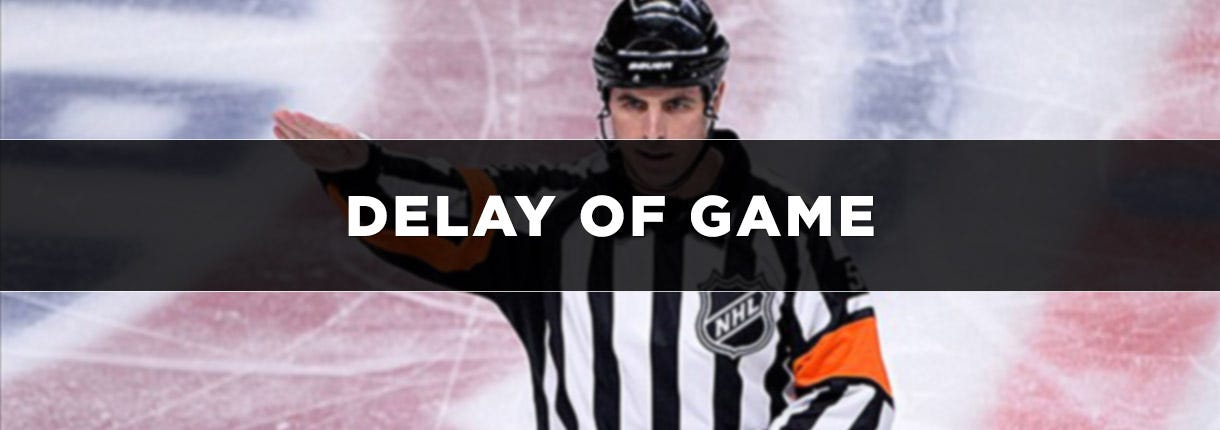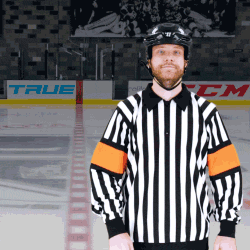Delay of Game in Hockey: The NHL’s Delay of Game Penalties

Delay of Game in Hockey is when it is determined by the referee that a team, or individual player, was intentionally attempting to stall the game.
There are a few different circumstances that will permit the referee to call a Delay of Game penalty, which will be discussed in detail later in this article. The result of one of these instances will usually result in a two-minute Minor Penalty, depending on the situation.
Shop our website for a wide variety of hockey equipment from all major Ice Hockey brands including CCM, Bauer, Warrior, and True.
- Referee Sign for Delay of Game
- What are the Penalties for Delaying the Game?
- The Official NHL Delay of Game Rule Text (Rule 63)
- The 8 Most Common Delay of Game Causes
- The Puck Over-the-Glass Controversy
Referee Sign for Delay of Game

Referee places hand across the chest, palm open facing down. Then fully extends arm in an outward movement directly in front of the body.
What are the Penalties for Delaying the Game?
Almost all the causes for a Delay of Game penalty will result in a two-minute Minor Penalty.
However, a Bench Minor Penalty will be called on a team if a team sends out too many players onto the ice. This can also be called when objects are thrown onto the ice, causing the game to stop. A Bench Minor Penalty would then be assessed to the home team.
Penalty Shots can also be called as well. If a player is on a breakaway, and the opposing goalie intentionally knocks the net off its moorings, the player will be awarded a Penalty Shot.
The Official NHL Delay of Game Rule Text (Rule 63)
A player, goalkeeper, or a team may be penalized when, in the opinion of the referee, is delaying the game in any manner.
The 8 Most Common Delay of Game Causes
As alluded to earlier, there are a variety of different causes that will call for a Delay of Game penalty to be called by the referee. The most common causes are listed below.
- A player or goaltender intentionally shoots or throws the puck out of the playing area.
- A defensive player in the defensive zone shoots the puck directly (without being deflected) over the glass. The penalty only applies if the player shoots it over the glass. If the puck is shot into the bench, no penalty is assessed.
- A player or goaltender intentionally knocks the nets goalpost off its moorings, which stops the play. If the net is intentionally knocked loose during a breakaway, the breakaway player is awarded a penalty shot. If there is not enough time in the game to serve the full delay of game penalty, the last player to take a shot is also awarded a penalty shot.
- The player or goalie intentionally keeps the puck behind the net for more than a minute.
- The goaltender freezes the puck rather than passing it on to a teammate when no player on the opposing team is within sufficient distance to apply offensive pressure to him.
- Any skater other than the goaltender uses their hands to make the puck unplayable (closing hand on puck).
- Fans begin to throw objects onto the ice or disrupt the game.
- Beginning in the 2017 season, an unsuccessful coach’s challenge for offsides results in the challenging team being assessed a Bench Minor penalty for Delay of Game.
The Puck Over-the-Glass Controversy
If a puck is shot over the glass and out of play by a player in their defensive zone, a Delay of Game penalty will be called. Where the issues lie is that before this rule was implemented, players were rarely intentionally shooting it over the glass. Fast-forward to today, this means that players are penalized for an accident or bad luck (shooting it over the glass).
Furthering the controversy are all the exceptions that go into this rule. If the puck grazes the glass, goes over the benches, or deflects off another player, it is not a penalty. These are just a few of many exceptions associated with this rule. And depending on the situation, this can make or break an outcome of a game.
A great example of another exception was recently seen in the gold medal game, Canada versus Russia, at the most recent World Junior Championship tournament. Minutes to go in the game, Canada held onto a 4-3 lead over Russia. Canada would take a penalty late in the game, resulting in a 5-4 powerplay for Russia.
As the video starts, you can see the Canadian player (black jersey, right side of the screen) attempt to backhand the puck out of his defensive zone. The puck was on its way over the glass until it hit a broadcasting camera and bounced back onto the ice. The play was stopped and was initially called a penalty for Delay of Game. The referees then talked it over and determined that the camera was “in-play” therefore reversing the call on the ice. This caused controversy because Russia would have gone on a 5-3 powerplay, but instead ended up losing the game 4-3.
This exception was made on-the-fly and left many people wondering what the outcome of the game would have been if a Delay of Game penalty was called against Canada instead.











